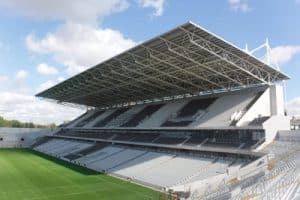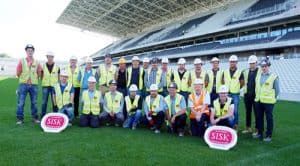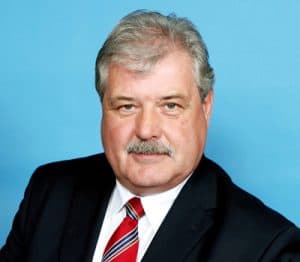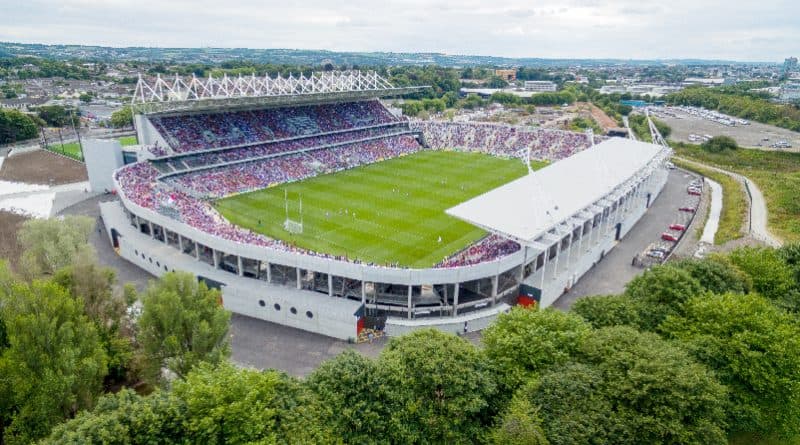John Sisk & Son Redevelop Páirc Uí Chaoimh – Cork GAA’s Colosseum
Irish building magazine took a tour of the redeveloped Páirc Uí Chaoimh stadium and spoke to members of the John Sisk & Son site team about the completion of the €70m project. This is a great achievement for Cork, the Cork GAA County Board, John Sisk & Son Ltd, the subcontractors, the Design Team, and the Gaelic Athletic Association not just regionally but also nationally.
Stephen Ryan, Sisk Senior Engineer on the project took us on a tour of the 45,000 capacity stadium, including the stands and terraces, which now has the most up-to-date public amenities for a stadium of this size, as well as the expansive players changing and welfare facilities and of course the exclusive conference centre. The pitch which has a totally new playing surface is in magnificent condition and is replicated by an all new full-size 4G All-adjacent to the stadium.

We can tell you that the facilities are superb and the stadium is a great example of the expertise of Sisk in stadium construction and the strength and capability of the Gaelic Athletic Association. We spoke to Dave Cotter, John Sisk & Son Regional Manager and the construction project manager, to find out about the construction and to Bob Ryan, Chairman of the GAA Steering Committee to get an overview of this large redevelopment.
Construction was completed on the original stadium in 1976 and it served Cork GAA for nearly four decades. In 2015 the redevelopment of the stadium began and this year on 19 July it reopened with a reported near 11,000 in attendance, as it hosted an Intermediate Hurling Championship match between Valley Rovers and Blarney. The stadium was opened for its first major inter-county games on 22 and 23 July with Tipperary playing Clare and Waterford playing Wexford in the Senior Hurling Championship Quarter Finals.
Stadium Redevelopment Team
John Sisk & Son were the successful bidders for the construction of the project back in 2015. Prior to this, they had redeveloped Croke Park and constructed the Aviva Stadium. Sisk completed the four stages of the Croke Park redevelopment, which was carried out over a 12 year period, while the ground was kept open for key games including All-Ireland Finals. Here in Cork, they had the benefit of a closed site. The Páirc Uí Chaoimh Design Team was comprised of other well-known local companies. Malachy Walsh and Partners were the Project Managers and Engineering Consultants, Scott Tallon Walker were the Project Architects – bringing the experience of working on the Aviva. Michael Barrett Partnership were the Quantity Surveyors and Cunnane Stratton Reynolds the planning consultants.
Tour of the Redeveloped Stadium
Irish building was given a tour of the entire stadium and viewed the pitch from a variety of angles from both the stands and the terraces. We were also given a comprehensive insight into the incredible range of facilities, particularly those in the South Stand. The stadium has a match day capacity of 45,000. The design maintains its original oval bowl shape, allowing for unrestricted views of the pitch.
The entrance gate and corridor for team buses and delivery vehicles behind the South Stand is spacious and brightly lit. This stand houses most of the facilities. Inside the grounds, there are four dressing rooms with connected showers and physio areas that provide great space for the movement of players on match days. The players’ tunnel shows the great workmanship of the block layers and concrete crews with high-quality fair faced block work and concrete. The team management areas and officials’ changing rooms are impressively fitted out with storage lockers and showers. There are first-aid rooms throughout the stadium for both players and members of the viewing public alike. The floor near these facilities has an artificial grass covering to prevent players, wearing boots, from slipping. The warm-up areas’ floor covering is the same with durable, damage-proof plaster board on the walls. In time one expects, that this will be greatly tested. There is also a large gym area, soon to house state of the art gym equipment.
 Walking out on to the field both stands tower over the field, primarily the 3-tier South Stand, giving an indication of the match day atmosphere. The main pitch, which was laid by Turftech, is in immaculate condition. There are floodlights over each stand and these will soon be put to use with the evenings closing in. Stephen says that the scoreboards were maintained from the old stadium and were given a new steel support structure and camera platforms in the redevelopment.
Walking out on to the field both stands tower over the field, primarily the 3-tier South Stand, giving an indication of the match day atmosphere. The main pitch, which was laid by Turftech, is in immaculate condition. There are floodlights over each stand and these will soon be put to use with the evenings closing in. Stephen says that the scoreboards were maintained from the old stadium and were given a new steel support structure and camera platforms in the redevelopment.
Inside the South Stand, we are shown the press conference area, the media rooms for journalists which are all fitted out with work stations and breakout facilities and the most up-to-date IT facilities of any modern stadium throughout Europe. The sizes of these areas are indicative of the increased media now covering Gaelic games compared to that of the mid-1970s. The concrete frame and support columns are exposed within the stands and they have a high-quality smooth finish. Stephen says this is due to the high standard of work by Hickey Formwork Ltd on the insitu concrete works and Banagher Precast Concrete on the pre-cast rakers and terrace units.
The television studio provides great views of the field from the west side of the South Stand and these will be visible during televised games over the coming years. Adjacent to the studio are meeting rooms, and the match day control room which has been fitted out with the most up-to-date security equipment.
There are often complaints, by teams and management, about grounds’ designs not having maximised the use of space but that cannot be said here, as all areas provide open usable space with no unnecessary wall recesses or obstructive projections. It is clear from the facilities that the design is well reasoned and the finishes are robust and durable where necessary and comfortable and hospitable where needs be.
The stadium is host to 13 bars and there are many hot food kiosks and confectionery shops dispersed throughout, with adequate space for queuing and returning to seating at half-time. The South Stand is host to the main commercial and hospitality areas. The Premium Level dining area is very spacious and there is also a meeting area for VIPs and a Private Dining Area. Within this level, there is an area for conferences and meetings of approximately 1500m2. The meeting rooms, offices and the like can be operated on a daily basis. The Premium Level pitch view allows you to walk up and down parallel to the field outside, giving a great view on match day. The glazing here was done by Hodgins Architectural Facades Ltd.
Outside the stadium, there is a full-size all-weather training pitch which can be viewed from inside the South Stand. There is sufficient seating for training matches and club games. Surrounding the stadium there are large granite paved and tarmacked areas. The paving was carried out by Premier Paving Ltd. and the tarmacadam was placed by Roadstone Ltd. Leading out of the ground, Stephen comments that the new stadium is more spacious allowing for an easier flow of pedestrian traffic. Speaking on waste management after match days or concerts, he tells us there is a waste facility in the stadium which allows for the compaction of waste prior to it being taken away by waste management companies. It is clear from the tour that no expense was spared in delivering top-class facilities. To find out more about the construction project we spoke to Dave Cotter, Regional Manager with John Sisk & Son and after to Bob Ryan, Chairman of the GAA Steering Committee to get the Client’s views on the completed project.
Dave Cotter, Regional Manager for John Sisk & Son tells Irish building about the bidding and preparation for the project, the work on site and the challenges, the Sisk project team, and his takeaways from the project. He’s proud of his team’s work, describing what it means to have overseen the redevelopment of a structure that is a major landmark and a place that is well-known and cherished by GAA supporters and the general public alike.
Bidding and Construction Planning
Dave says that this project was hugely important. “John Sisk & Son Ltd. was founded in Cork in 1859 and we have a regional office in the city. We have completed many major projects in Cork down through the years. This was a high-profile job within the GAA world and among the general public.” He says a lot of work went into the tender stage. “We had been tracking the project for a number of years before it came to tender. We developed our team, the majority of whom had worked on large scale concrete and steel projects both here and in the UK. They were incredibly competent and highly experienced individuals who gelled into a team very quickly. When it came to tender we had an execution plan in mind, with a team and subcontractors ready. Knowing the optimal sequence of construction, being innovative in our approach and understanding both what the challenges were and the Client’s specific requirements, all proved critical to us being awarded the job.”
Dave says the success of the project was down to the rigorous and methodical planning at the commencement of the project and all the way through. BIM was a very useful tool to facilitate this. “We utilised BIM to identify our construction sequence and develop our programme. We used it for clash detection and to see the finishes on the stadium. It was a great visualisation tool. It was a complicated structure and it was necessary to see the elevations and interiors and the personnel flow from different viewpoints.”
Client’s Brief
Dave describes the site and surrounds: “The GAA owned the footprint of the stadium and they purchased additional land from Cork City Council where the old show grounds were located. This facilitated the increased size of the stadium footprint and the provision of a full-size all-weather training pitch to the south of the stadium. The land around the stadium is being developed by Cork City Council as a municipal park. This titled ‘Marina Park’ will be a fantastic setting for the stadium when completed and will be a great amenity for the people of Cork and tourists alike.” Sisk participated in a detailed Value Engineering exercise at the early stages of the project. “We engaged in a very comprehensive VE exercise with the Client and their Design Team. This proved very successful and allowed the Client to maintain their budget and protect the parameters of the project that were most important to them.”
He outlines the Client’s brief: “The brief was to construct a 45,000 capacity stadium and centre of excellence for the Cork GAA County Board. 21,000 of this capacity was to be seated and enclosed in the stands. The balance of 24,000 would be on the terraces in a similar layout to the previous stadium but obviously with a larger footprint. Space and the free movement of people was very important to the Client. The time frame for construction was 19 months. The new 3-tier South Stand was to have a lower and upper tier capacity of 5,400 seats each, accounting for 10,800, with the balance of 2,200 seats in the middle Premier Level tier. The North Stand, also enclosed, would have a capacity of 8,000 seats in one large single tier. The GAA wanted to maintain the bowl shape dimensions of the old stadium because of the atmosphere that this generated.” He says, “Originally, the new stands were to be built in the footprint of the old stands with no construction access permitted to the pitch area. However, a decision was made, approximately 10 months into the project, to redevelop the playing surface. This allowed restricted access to the outer perimeter of the pitch.”
Dave describes the facilities in the finished project. “The 3-tier South Stand is the main stand, this doubles as a conference centre and this will be in use outside of match days. There are a number of different meeting rooms, all with the most up-to-date audio visual facilities. They are serviced with a fully functional kitchen and restaurant which will have the capacity to cater for large functions. In time, there will be a museum and a sports retail outlet. There are four fully fitted-out players changing rooms with physio facilities, showers, and warm up areas. Each team will have a dedicated manager’s room. The referee and match officials have their own changing area with all the required facilities. There is a large gym which will facilitate the needs of the county’s squads. For the media, there are fully equipped press work areas in the stands, a press work room, a tiered press conference room, a TV studio, and offices. The standards of finishes in these are very high and to an international standard. The conference area has high-spec finishes and this was due to the great work of Scott Tallon Walker.” From our tour, it is obvious that great consideration is given to space, foot traffic, and convenience. Dave adds: “Evacuation times were of great importance and we needed to facilitate the movement of people. There are food facilities, bars and toilets everywhere in the stadium to provide the convenience of not having to travel around to find them.”
Project Programme
The project kicked off in March 2015 and the demolition and piling were awarded directly by the Client prior to Sisk arriving on site in December. “We took on the remainder of the piling and demolition and we went on to construct the stadium from there,” Dave says. Speaking about the waste management from demolition, Dave praises the work of Loftus Demolition. “Loftus carried out the demolition and did a good job. Loftus became a nominated subcontractor for Sisk when we were awarded the project.” Sisk have worked with them on many big projects.

Condensing the large project programme into a summary, he says, “When we finished demolition, all that remained was the support structure for the two terraces. As these were in good condition, the Design Team decided that they should be retained. The stands and the terraces were demolished. We started on site on 7 December 2015 and it was a wet winter. We completed the piling in January, along with the remainder of the demolition and started the foundations. We came out of the ground, with the first concrete rising elements in February 2016. We had decided to build the middle and upper tiers first, having our cranes and equipment located in the footprint of the lower tier. This allowed us to get very close to the structure, reducing the size of the heavy lift cranes, allowing for greater safety and efficiency of construction. Once the middle and top tiers were complete and the roof was in place, we constructed the lower tier. The weather continued to be very wet until March 2016 when we were finishing the foundations. From this until late summer 2016 it was about in-situ concrete, working on all four stands simultaneously. By early summer we had commenced the precast tiered seating elements on the North Stand. On the South Stand, the first precast elements started in September. We made the decision to preassemble the main 50m long roof trusses on the ground and lift them in pairs. This allowed us to start the roof assembly much earlier and it substantially reduced the amount of working at height, which obviously made the project much safer.
A 750-tonne crane was used to install the roof. From September ‘16 to February ‘17, it was all about the precast concrete on the South Stand and terraces and the installation of the stadium roof. We had dedicated Sisk management teams on each of the stands, with a separate team managing the scope of the external works. At this time we commenced the internal fit-out, with a separate management team dedicated to this exclusively. From March ‘17 to June ‘17, the main focus was on the internal and bowl terrace fit-out and thereafter the final commissioning to July 17 when the stadium opened. Whilst the stadium is powered from the ESB network during non-match days, it is supplemented by up to 4 large generators, depending on the attendance and on whether the flood lights are in use. The fit-out of the bowl area, which included seating, crowd control barriers, handrail and balustrading was not to be underestimated. There were 5 different contractors working on the secondary steel alone. The 11 July was the day we finished.”
Key Challenges
Dave tells us that at the beginning of the project the main challenges were the weather conditions and the sourcing of construction expertise and skills when the industry had really just begun to recover. “We started in a wet winter, there was a lot of groundwater and we were working deep in the ground, below the water level of the adjacent Lee which was high. It was a challenge to get ‘out of the ground’. We constructed a large settlement pond on one side of the site to allow any silt in the pumped waters to settle out. We had to make sure that the water coming out of the site was not contaminated and clear of silt. We tested it on a daily basis and reported to the City Council.”
“The personnel working on the project peaked at 550, but on average we had 300 to 350 people working on site,” he tells us. “The pace of construction meant that we needed a lot of local resources and we managed to source these from Cork and the surrounding region. The concrete and formwork contractor peaked at 150 people and we thought it would be a problem to source this number of skilled trade, but it wasn’t.”
His account of the design and construction and importation of the roof is very interesting. “For the roof, we had to source a contractor in Austria who had experience of these types of stadium roof before,” he says. Dave describes the work involved in getting the roof in place. “The roof is a tubular steel truss structure. The roof required a great level of precision in fabrication and execution. It was fabricated in Poland and a team was sent over to Cork for assembly and erection of the steel. All the roof steel was preassembled on the ground. Each pair of trusses weighted 65 tonnes and were lifted into place with the 750-tonne crane. This was efficient and from the point of view of the schedule was a huge advantage as it allowed us to work on the precast structure while the roof was being assembled on the ground. The roof was put together in two phases: assembly of the steel, and putting it into place. There was less time spent working at a height, which was good for health and safety.” The project’s construction planning and all-round reasoning to meet requirements, the programme and improve buildability is impressive.
Sisk’s Site Team
From the tour of the stadium, hearing about and seeing the work of the different trades and specialist subcontractors, we knew that this project required management personnel with diverse skill sets and areas of expertise ranging from groundworks and concrete to steel work, fit-out and finishing. Dave tells us about the structure of the team, the allocation of tasks and the experience the team gained. “The overall structure of the team was important. It was the most incredible team I have ever seen come together. It was a complex and challenging project constructed in a short time frame,” Dave tells us. He proceeds to describe Sisk’s wealth of expertise. “We liaised with our colleagues in Dublin to bring the experience from the Aviva and Croke Park projects. A lot of the guys on the team had experience on large UK power plant projects. We had a diversity of specialists on the team, guys with experience of working on big concrete and steel structures, but we also have guys experienced in the technology and retail sectors who specialise in fit-outs and finishing.”
He describes the on-site organisation: “We had 5 separate teams within the group one for the each of the South Stand, the North Stand and terraces, the externals and the training pitch, one for the fit-out of the bowl within the stadium and one team dedicated to finishes within the stands. This worked very well. We also had a ‘package owner’ system, whereby one person would be responsible for each package of work.”
Many of the team that worked on the stadium are now moving on to the Curragh Racecourse Redevelopment project and he says they will carry with them the great experience they have gained on this project. Dave believes that the experience gained by the Sisk team on the stadium was influential in Sisk winning the Curragh job.
On Site Communications
There was in excess of 75 subcontractors employed and the onsite personnel peaked at 550. Discussing the project’s coordination Dave tells us about the communications on-site. “We had a morning briefing at 7.30 each morning. We had daily whiteboard Health & Safety meetings, twice weekly progress meetings and weekly technical meetings with the key subcontractors. We had our Client Team meetings each Thursday and this was critical for us to get feedback on the works as they progressed. As we came close to closing on the project we had almost daily meetings to schedule the works for each area. This allowed optimal efficiency and great quality assurance and quality control.”
Quality Standards
We ask Dave about the overall quality standards and finishes for the project. “The feedback from the Client and the Design Team has been great,” he says. “The in-situ concrete, precast concrete, and the blockwork which are the most visible elements of the construction were completed to a very high quality. The painting of the roof was very important because we were in a semi-marine environment. We flew a specialist steel fabrication and painting team out to Poland on a number of occasions to ensure that the specification was strictly adhered to. Failure to apply the correct product properly could lead to premature deterioration of the steel in this environment. The view on the materials used in the elevations has been very affirmative. The internal finishes were completed in a meticulously systematic fashion to ensure that they were completed to a very high standard also.”
Great Feedback and Project Takeaways
The feedback from the GAA and the general public has been very positive. “We got great reaction from players, the GAA and the public. Great credit is due to Malachy Walsh and Partners, Scott Tallon Walker and Michael Barrett Partnership,” Dave adds. Thinking back on the project, Dave states: “We are proud to have worked on such a high-profile project which the public will be able to use and enjoy for decades to come and it will be the location for many great sporting occasions.”
We ask what his takeaways will be from this. Dave says he will remember the teamwork and enormous dedication of Sisk’s staff and the supply chain. He tells us, “It took hard work and dedication to deliver this project in the time frame. Backing from the Client’s Team was also critical. We had great help from our supply chain. The vast amount of time spent sequencing the works and the planning of the project paid major dividends.”
Bob Ryan, Chairman of the Steering Committee for the Redevelopment of Páirc Uí Chaoimh

Bob Ryan, Chairman of the Steering Committee for the Redevelopment of Páirc Uí Chaoimh talking to Irish building about the finished project says all the stakeholders are very pleased after years of planning and preparation. “The redevelopment has been in the planning for many years. The procurement of the surrounding land made the project possible. We acquired land from Cork City Council which took a few years to finalise. The detailed planning started in 2010 when we engaged Malachy Walsh and Partners as consultants. We went through the planning process, received planning in 2014.The tender process took some time and John Sisk & Son was appointed the contractors and construction began in 2015. You can see here that it is a superb stadium, the players, and GAA community are very happy with it. I think it means a lot for the whole region: Cork City and County.”
He speaks positively about the business potential of the stadium. “It will be a major venue for Senior Hurling and Football Championship and League games, inter-county games at various levels, club games, and for concerts. Ed Sheeran will play here for three dates on 4, 5 and 6 May 2018. Hopefully, it will be a venue for the Rugby World Cup 2023. It will be a major boost for the economy here in the coming years. There is a conference area and meeting rooms, bars and dining areas and these are available for local businesses and the community.”
Concluding our chat, Bob says, “I want to thank everybody involved. We got great support from our GAA Head Office in Croke Park throughout the project’s duration. It is a great achievement for all involved.”
Irish building thank John Sisk & Son and Cork GAA for the tour of the stadium. This was a great opportunity to see the capabilities of John Sisk & Son and their subcontractors in delivering a stadium which will be the venue for many great sporting occasions and concerts and events in the decades to come.


